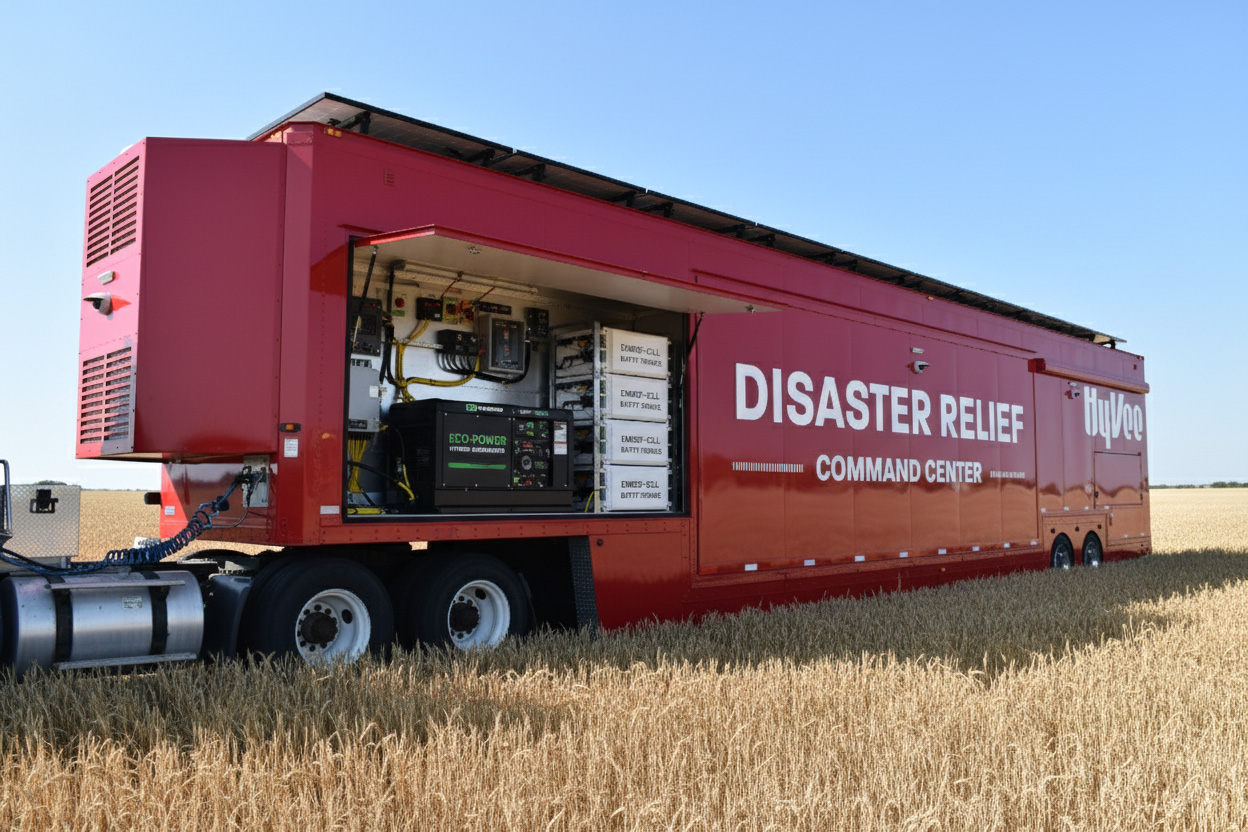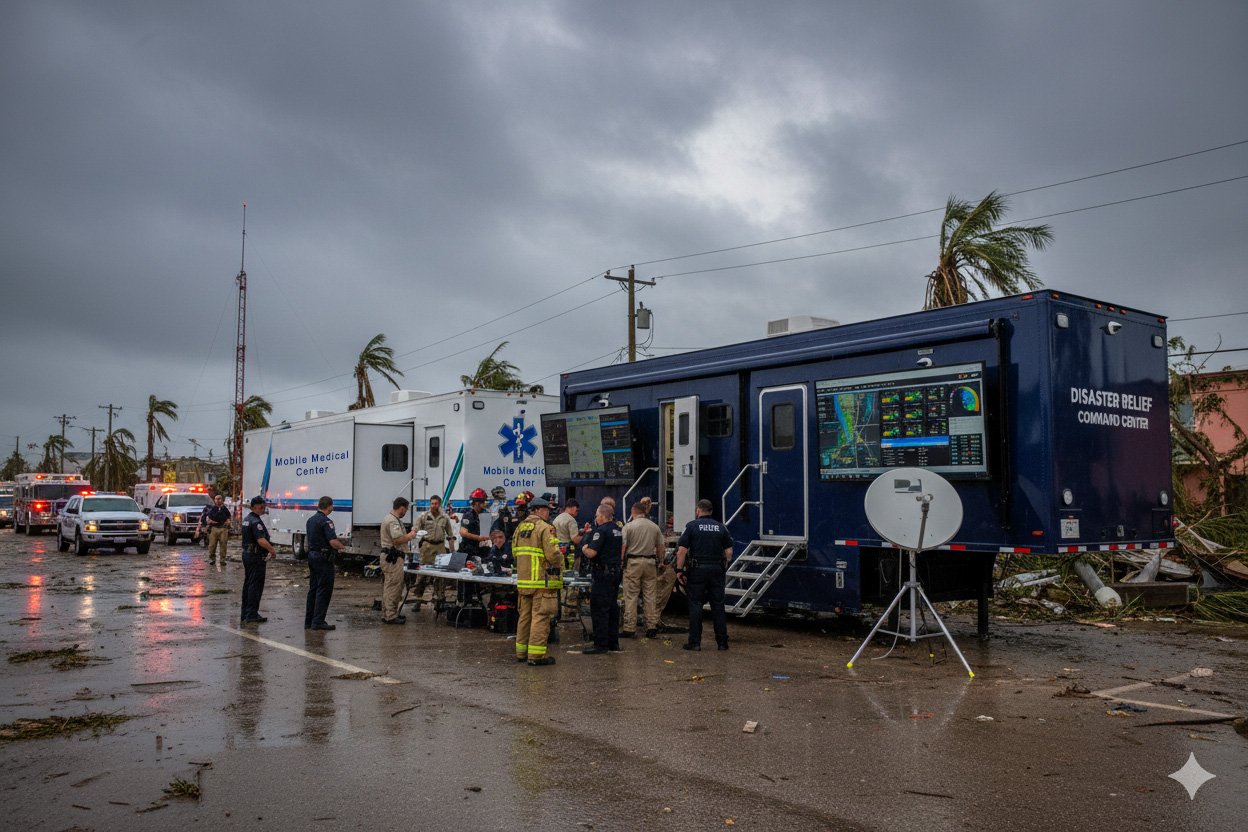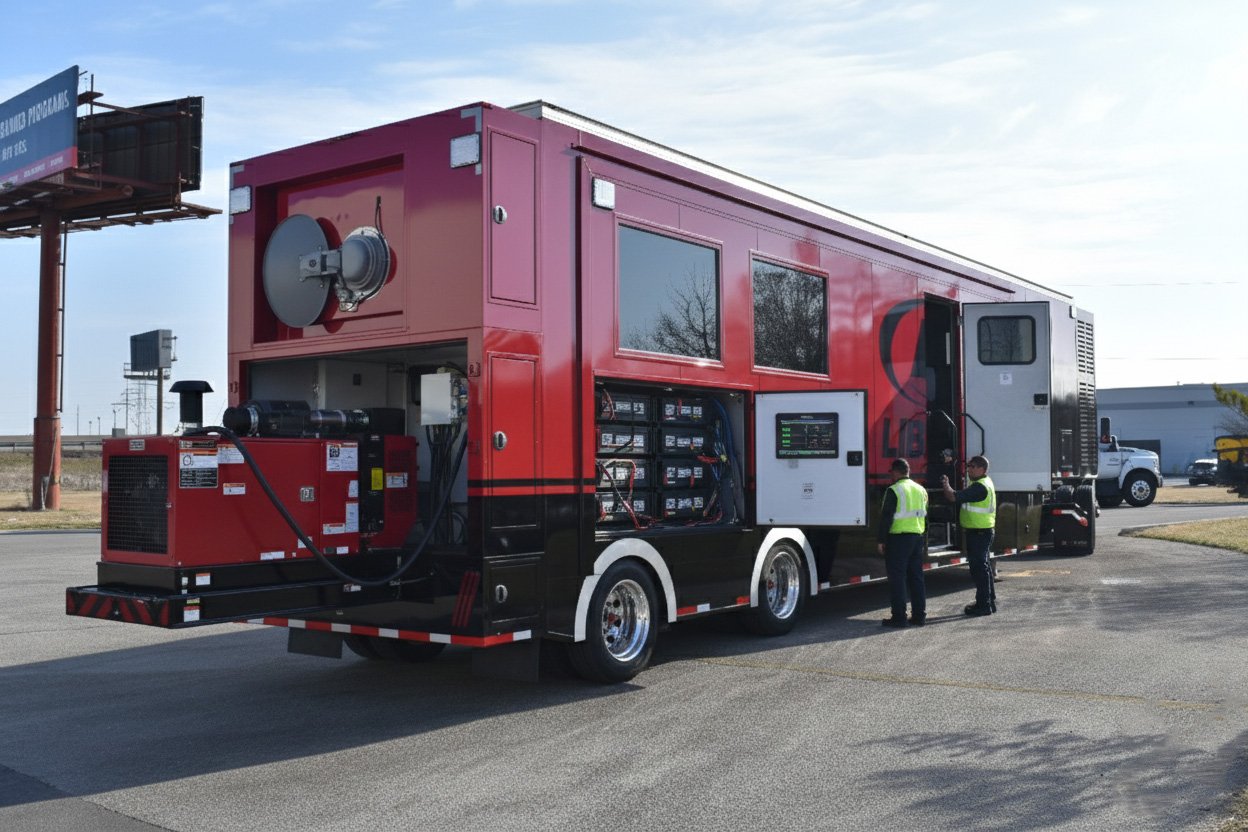How Mobile Medical and Command Units Work Together in Disaster Relief
When disaster strikes, speed and coordination can mean the difference between life and death. Responding to hurricanes, floods, or earthquakes...
10 min read
Craftsmen Industries Nov 20, 2025 4:13:31 AM

In an era where rapid-response capabilities are increasingly vital, the investment in a mobile command center (MCC) has become more than just a tactical decision; it’s a strategic financial one. With the global mobile command center technology market projected to reach over USD 6 billion by 2033, agencies worldwide are committing significant resources to deploy these units. Yet, despite major market growth, many procurements stumble when budgets don’t fully account for long-term costs, lifecycle upgrades, and mission-readiness requirements.
Take, for example, the case of the Sarasota Police Department in Florida: their 40-foot mobile command center was delivered at “just less than US$925,000.” It sounds like a headline cost, but what about the ongoing communication upgrades, operator training, insurance, fuel, and maintenance that accompany it?
Let’s explore what makes up the total cost (chassis, systems, interiors, power), segment cost tiers from small deployables to full-scale command vehicles, identify hidden and recurring expenses, examine technology’s impact on budget escalation, and sketch out purchasing strategies, funding paths, and lifecycle management tactics.
Whether you’re a procurement manager in a municipal fire or police department, a military or defense planner, or a facility manager in the utilities sector evaluating a command-capable van or trailer, this article is written for you. By the end, you’ll have a clear roadmap to estimate initial investment, plan for recurring expenditures, anticipate upgrade cycles, and build a budget that supports mission success, not just acquisition.
Let’s begin by breaking down exactly what components contribute to the “total cost” of a mobile command center, and how each category can influence your bottom line.

When budgeting for a mobile command center (MCC), the vehicle’s sticker price rarely tells the whole story. Each MCC is a complex ecosystem of mobility, technology, and operational infrastructure, and every component affects the overall cost. Whether you’re designing a compact communications van or a full-scale tactical command unit, understanding where your money goes is the first step toward smart procurement.
The foundation of any MCC is its chassis, typically built on truck, trailer, van, or bus platforms. Heavy-duty truck or coach chassis from manufacturers like Freightliner, Ford, or Mercedes-Benz form the backbone of mid-to-large units.
The cost can range from $80,000 for light-duty vans to $300,000 or more for specialized all-wheel-drive or off-grid platforms. Larger units, such as expandable trailers used by FEMA or law enforcement, can exceed half a million dollars before customization even begins.
Technology is the most expensive portion of an MCC build. Core systems include:
Advanced systems that integrate real-time situational awareness tools or AI-assisted analytics can raise total costs significantly. For instance, integrating a dual-satellite failover system may add $50,000–$100,000 to the budget but ensures uninterrupted communication during disasters.
Interior layout directly influences operator efficiency and comfort.
Costs cover:
Luxury materials or modular control layouts for multi-team use increase this cost segment. Agencies prioritizing long deployment durations often invest more heavily in climate control, seating, and soundproofing.
MCCs rely on independent power sources such as diesel generators, solar panels, or battery storage systems. Redundant systems ensure continuous operation during outages but also drive up costs. Hybrid power setups may add 5–8% to total expenditure but significantly reduce long-term fuel costs and noise output.
Final system integration, software calibration, and on-site testing ensure everything functions seamlessly. These processes may seem minor but can cost $20,000–$50,000, especially for units using multiple satellite and radio systems.
When planning for a mobile command center (MCC), the mission and deployment scenario affect cost just as much as physical components. By aligning budget parameters with real-world use cases, agencies can more accurately forecast expenses, avoid over-specification, and ensure the investment supports the intended operations.
In scenarios such as public festivals, sports events, or temporary field operations, an MCC may only be needed for a limited timeframe (hours to days). Because mobility and rapid deployment are priorities, the budget should favour lighter-weight chassis, quicker setup features, and minimal long-term commitments.
For example, the Federal Emergency Management Agency (FEMA) schedule lists hourly rates for smaller command units starting under US $30 for trailers. In this scenario, the capital footprint is lower, but logistics and rapid readiness become budgeting hot spots (transport, setup crew, connectivity).
For larger deployments like regional emergency or disaster response command centers, regional utility outage response, or multi-jurisdiction operations, the MCC must sustain operations for days or weeks, support multiple workstations, redundant power, and robust connectivity. Costs escalate accordingly: more powerful chassis, satellite/mesh links, redundant power systems, and on-site accommodations (HVAC, living quarters) become essential.
Some organizations (military, large telecoms, utilities) operate MCCs as part of their long-term infrastructure; they may move equipment, but the expectation is multi-year service and high reliability. In these use cases, budgeting must cover full lifecycle costs: estimated 10–15 year replacement cycles, mid-life upgrades, insurance, depreciation, and training.
When you finally sign on the dotted line for your mobile command center (MCC), the purchase price isn’t the finish line, it’s really the starting point. Below are crucial cost categories that many buyers overlook, along with practical tips you can use to budget ahead.
Purchasing the vehicle is just the beginning. You’ll need to account for:
Technology changes fast, and what’s cutting-edge today can feel dated within a few years.
Having the vehicle is one thing; running it is another, often overlooked, cost centre.
Model your expected “deployment days” per year and estimate per-day fuel/power, connectivity, operator hours, and wear-and-tear costs. Multiply that by 3-5 years to get your operational tail-cost picture.
Owning the unit doesn’t guarantee that you can fully deploy it. Personnel training and staffing are essential.
Last, but definitely not least, include:

Technology is the beating heart of any modern Mobile Command Center (MCC). It defines how effectively your unit operates in the field, and, at the same time, it determines how fast your budget can escalate. From communications gear to surveillance tools, each system you add contributes to performance but also increases cost, maintenance, and training needs. Striking the right balance between innovation and practicality is what separates a smart investment from an overbuilt expense.
Reliable communication is the foundation of every command mission. Modern MCCs depend on a web of technologies such as LTE routers, radio systems, and satellite uplinks to ensure that no team is ever cut off during an emergency. Investing in strong communication systems enhances operational control, especially in disaster zones where regular infrastructure fails. According to FEMA, maintaining uninterrupted communication is the backbone of effective disaster response. Organizations that prioritize modular and scalable systems are better able to adapt as new technologies emerge without overhauling their entire setup.
Surveillance equipment, from high-definition cameras to infrared sensors, extends the command center’s reach far beyond its walls. These technologies help operators monitor vast areas, detect threats, and make faster, data-driven decisions. While advanced sensors and camera networks can increase upfront costs, they also reduce human error and improve situational awareness, offering long-term value for agencies that need precision and accountability in the field.
Behind every screen inside an MCC lies a powerful software ecosystem that manages data, live video, maps, and communications. Command and control software enables teams to visualize complex situations and allocate resources more effectively. However, these systems often come with ongoing licensing or subscription costs that can grow over time.
Every piece of technology in an MCC draws power, and keeping it running efficiently requires thoughtful planning. Diesel generators, battery banks, or hybrid solar systems are all common solutions, each with different trade-offs in terms of fuel use, reliability, and noise. Integrating renewable or hybrid systems early can significantly reduce long-term operational costs and carbon emissions.
As mobile command units become increasingly digital, cybersecurity has become just as important as physical protection. Encrypted communications, firewalls, and intrusion detection systems are now standard to safeguard mission-critical data. Agencies that invest early in cybersecurity infrastructure not only protect sensitive data but also ensure operational continuity in the event of a digital threat.
Finally, combining all these technologies into one seamless system is both art and science. Integration requires specialized expertise to ensure that every component, from cameras to servers, functions harmoniously under real-world stress. Thorough testing helps identify weak points before deployment, preventing costly downtime later.

One of the most important budget decisions when planning a Mobile Command Center (MCC) is whether to purchase a standard model or go for a fully customized build. Both have pros and cons, and choosing the right path depends on your mission requirements, deployment frequency, and long-term operational capacity.
Standard MCCs are typically pre-designed units with published layouts and common component sets. They’re faster to deploy and often cost less upfront because much of the engineering and integration is already done. For smaller agencies or teams needing rapid readiness, this can make a lot of sense.
Using a standard model can reduce the variables, fewer unique parts, simpler maintenance, quicker training, all of which help keep lifetime costs predictable. The trade-off is less flexibility: if you need non-standard features you might be constrained.
A custom MCC is built around your specific mission profile. Every work-station, communication rack, power system, and interior layout is tuned to your operations. For agencies with complex, long-term deployment needs (e.g., multi-agency command, disaster recovery, utility network operability) customisation can offer efficiency gains. For example, tailored systems mean fewer workarounds, less crew confusion, and faster decision-making.
However, customisation also introduces risk: longer delivery timelines, potential for scope creep, greater integration complexity, and higher maintenance overhead. A significant number of large IT-related acquisitions face major challenges: in one analysis of 16 mission-critical acquisitions, the total cost was estimated at over US$51.7 billion, and many faced risks in schedule, workforce, and technology implementation.
If you decide on a custom, you should make sure the vendor has proven experience, allow for realistic delivery schedules, include contingencies for changes, and budget for long-term sustainment, not just the upfront build.
Many agencies find a “best of both worlds” approach by starting with a standard chassis or base configuration and selectively customising key subsystems (communications, power, network infrastructure). This hybrid approach limits initial cost while giving operational flexibility where it matters. Some planning guides suggest that hybrid builds can reduce overall cost compared to full customisation while still meeting most mission demands.
When evaluating options, focus not just on features but on operational value. Ask:
The key takeaway is clear: smart budgeting is not about cutting corners but about aligning operational goals, technology, and total cost of ownership. When it comes to execution, few names carry the trust and technical depth of Craftsmen Industries. With decades of experience in mobile command center fabrication, Craftsmen specializes in custom-engineered, mission-ready solutions for government, military, and private sector clients.
Their end-to-end services, from structural design to communication systems integration, ensure every MCC is both cost-effective and performance-optimized. Partnering with a proven manufacturer like Craftsmen Industries streamlines procurement and guarantees compliance with safety, electrical, and communication standards across deployments.
If you’re ready to bring your vision to life, visit Craftsmen Industries to start building a custom mobile command center that meets your mission needs and budget.
The cost of a Mobile Command Center (MCC) depends largely on its size, onboard systems, and mission-specific equipment. Smaller van-based MCCs used for regional coordination or short-term deployments generally cost between $150,000 and $350,000, while mid-sized truck-based command vehicles can range from $400,000 to $800,000. Large, fully equipped command centers with advanced communications, satellite links, and multi-room layouts often exceed $1 million.
The most significant pricing differences between vendors usually arise from the quality of fabrication, technology integration, and after-sales support. Two vehicles of similar size may have dramatically different long-term costs depending on the quality of their electrical systems, data infrastructure, and environmental control units. Labor charges and lead times can also affect final pricing, especially if a project involves complex integration of satellite communications or cybersecurity infrastructure.
Many agencies secure MCC funding through a combination of local budgets, federal grants, and public safety programs. The Federal Emergency Management Agency (FEMA) and the Department of Homeland Security (DHS) both administer grant programs that cover mobile communication and interoperability infrastructure under emergency preparedness initiatives.
A well-maintained Mobile Command Center typically remains operational for 10 to 15 years, though technology refreshes may be required every five years. Vehicle components such as engines and generators usually outlast onboard electronics, which can become obsolete more quickly due to software and compatibility changes.
Smaller departments often choose modular or semi-custom builds to minimize upfront expenses while retaining flexibility. Starting with a standard chassis and integrating only essential systems, such as communications, power, and data monitoring, can significantly reduce costs. Additionally, phased upgrades allow agencies to expand capabilities over time without exceeding budget limits.
Yes. Federal and state agencies regularly offer grants and financing assistance for public safety infrastructure, including mobile command vehicles. Programs under FEMA’s Homeland Security Grant Program (HSGP) and DHS’s Urban Area Security Initiative (UASI) provide funds specifically for interoperability and disaster response communications.
Lifecycle management plays a crucial role in ensuring that the total cost of ownership remains manageable. Studies by the U.S. Government Accountability Office indicate that maintenance and operational costs can account for up to 70% of total program expenses after deployment. By adopting proactive maintenance schedules, keeping software up to date, and replacing components before they fail, agencies can extend operational life and reduce unexpected repair costs.

When disaster strikes, speed and coordination can mean the difference between life and death. Responding to hurricanes, floods, or earthquakes...

When a mobile command center doubles as an office, productivity hinges on intelligent design. These units are more than vehicles with desks; they are...

Mobile Command Centers (MCCs) are the backbone of emergency response, corporate field operations, and even large event security. They serve as mobile...